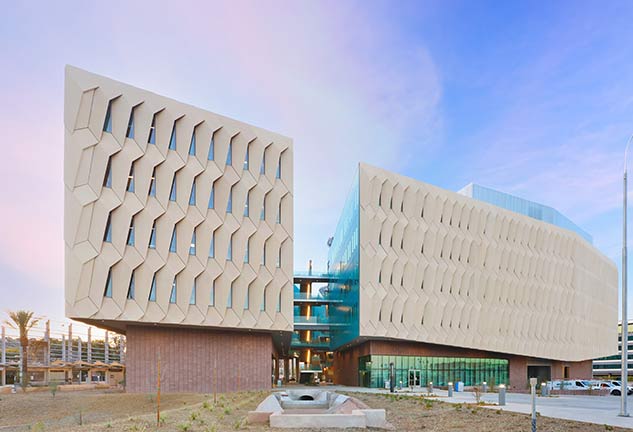
Construction is complete on the new $192-million Interdisciplinary Science and Technology Building 7 project at Arizona State University in Tempe. The approximately 281,000-gross-square-foot, five-story, high-performance research facility, now known as the Rob and Melani Walton Center for Planetary Health, promotes an interdisciplinary approach to knowledge generation and leading-edge research intent on improving life on the planet. Designed and constructed as a collaborative research facility, it utilizes clusters whereby researchers of varying disciplines work collaboratively to address global challenges, and support innovative endeavors, to improve the planet’s health and sustainability of food, water and energy into the future.
Serving as the eastern gateway to campus, the new research facility provides engagement opportunities for the public to see how ASU research is changing the world. In addition to public outreach and exhibit space, The Walton Center for Planetary Health is home to the Julie Ann Wrigley Global Futures Laboratory, the Rob and Melani Walton Sustainability Solutions Service, the School of Sustainability, the Institute of Human Origins and a five-story atrium.
The laboratories, classrooms and offices are clustered around a building nexus, promoting innovation, excellence and transdisciplinary collaboration through heightened experience and connectivity. ISTB7 contains 70,000 square feet of wet and dry lab space, a conference and education center with a 389-seat presentation hall, university classrooms and faculty and staff offices. Dry lab space includes computing, cyber-security, engineering design and fabrication and robotics. ISTB7 also has research labs for biological sciences, engineering, life sciences and sustainability.
The building is located at one of the busiest intersections in Arizona. During the preconstruction process, the site was revealed to have a rich archaeological history. To respect and celebrate the unique site features, less than 50% of the building floor plate touches the ground where more than 1,000 years ago, the Native Americans processed foods like mesquite pods and agave onsite, and later the site housed the Kirkland-McKinney irrigation canal, a stagecoach route and the first all-weather transcontinental highway. The canal was preserved and incorporated into the design of the building and many historical elements were preserved and are featured in the new structure.
The project team also prioritized reducing the building’s carbon footprint throughout design and construction. Low-carbon footprint strategies involved a range of innovative approaches, from material selection and interior layout design, to optimized energy performance and water-efficiency solutions. Strategies include the use of fly-ash concrete admixtures and positioning the project as the first building in Arizona to use BubbleDeck, a void-form structural deck system which significantly reduced the carbon footprint and embodied energy inherent in concrete structures. In addition, significant consideration was given to the location of wet labs, selection of building envelope and the use of a radiant cooling system. Methods utilized to save and produce energy and create a comfortable microclimate include directing natural air currents, evapotranspiration and photovoltaics. The complex also captures mechanical system condensate water and use of non-potable water from the Salt River Project ditch to supply drip irrigation to the landscape, reducing reliance on treated municipal water.
The building’s overall design was inspired by the desert with the exterior panels based on biomimicry of a saguaro, which shields itself from the heat with the deep pleats of its skin. ISTB7’s south-, east- and west-facing windows are shaded by angular exterior wall panels, while north-facing windows are barely covered — a strategy that also reduces the building’s energy usage, while maximizing natural light. The exterior shell of glass-fiber-reinforced concrete panels absorb and store less heat, while the bright interior courtyard features sparkling glass, and cool aqua-colored panels, inspired by the Grand Canyon’s Havasu Falls.
ISTB7 is the latest among dozens of LEED projects on the ASU campuses and is by far one of the most ambitious, pursuing LEED Platinum status.
The project team included general contractor McCarthy Building Companies, architects Architekton and Grimshaw Architects. Other trade partners included Sherwood Design Engineers, Dibble Engineering, Buro Happold, TDIndustries, Wilson Electric, Ten Eyck Landscape Architects, Thornton Tomasetti, MKB, The Sextan Group/NV5, Colin Gordon Associates; ISEC, Inc., GrEn A/E Consultants, Walters & Wolf, Jensen Hughes and RLB.


 Join our thriving community of 70,000+ superintendents and trade professionals on LinkedIn!
Join our thriving community of 70,000+ superintendents and trade professionals on LinkedIn! Search our job board for your next opportunity, or post an opening within your company.
Search our job board for your next opportunity, or post an opening within your company. Subscribe to our monthly
Construction Superintendent eNewsletter and stay current.
Subscribe to our monthly
Construction Superintendent eNewsletter and stay current.